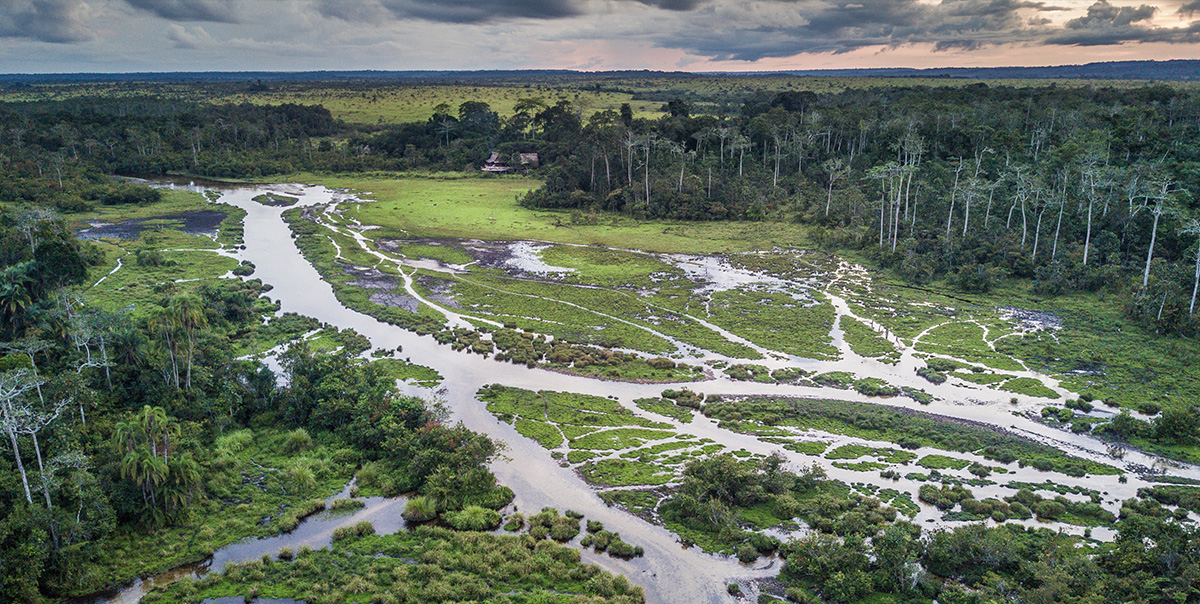
Bais are among the most enchanting features in the Odzala-Kokoua National Park. The natural beauty of bais offers a unique opportunity to observe animal behaviors and interactions in an undisturbed environment. Bais are not only ecological hotspots but also places of profound wonder, inviting all who visit to connect deeply with the heart of the tropical forest.
The Fascination of Bais
Distribution and Unique Nature
Bais are scattered across western Central Africa and even in parts of the Congo Basin. They are prominent in the Dzanga-Sangha Reserve of the Central African Republic and in national parks in northern Congo and Gabon.Origin and Maintenance
- It is believed that bais are remnants of larger grassy wetlands gradually overtaken by forests.
- Large mammals, particularly elephants, play a crucial role in maintaining these open spaces by disturbing the soil and vegetation, which prevents complete forest colonization. This activity helps keep the baïs open and supports their unique ecosystem.
Sources of Minerals
While the general origins of the bais are known, the specific processes contributing to their mineral richness are still not fully understood.- Initially, scientists believed that the minerals in the clearings were drained from the surrounding forests by surface waters and then concentrated through evaporation. However, the waters flowing out of the surrounding forests are so mineral-poor, making it unlikely they caused the high mineral levels in the clearings.
Recent studies highlight the roles of geological processes and animal activities in the mineral content of bais. - Geological Contributions: The presence of volcanic rock (dolerite) near the surface in areas like Dzanga Bai, in the Central African Republic contributes significantly to the mineral content of the water and soil. This geological feature releases essential minerals and salts. (NASA Earth Observatory), (PLOS)
- Animal Activities: Elephants enhance the mineral richness of bais by digging into the ground to access mineral-rich water and disturbing the soil. Their frequent visits and activities, such as defecating and urinating, further enrich the soil with minerals (Mongabay: Salt Licks for Elephants).
Attraction of Large Mammals
Bais are magnets for large mammals from neighboring forests, especially elephants, buffalo, gorillas, bushbocks, giant forest hogs, and sitatungas.Impact of Wildlife Decline
- Ecological Consequences: With fewer elephants, there is an increase in woody vegetation and a decrease in mineral-rich areas. Elephants are essential for preventing forest encroachment and maintaining the open nature of baïs, ensuring the availability of minerals and maintaining the ecological dynamics necessary for various species.
- Biodiversity Loss: The decline in elephant populations disrupts the ecological functions of bais, leading to reduced biodiversity. As elephants shape the environment, their absence results in a less attractive habitat for other wildlife, diminishing species diversity and ecosystem health.
.jpg?width=1200&length=1200&name=00028Lango%20-%20Ga%C3%ABl%20R%20Vande%20weghe(1).jpg)





Exploring the Bais/Wetlands
At Odzala National Park, researchers studied elephant movement by mapping and describing their paths through forest clearings and Marantaceae forests. They identified three types of paths based on direction, length, width, elephant activity, and the forests they traverse: boulevards, foraging paths, and clearing alleys.
- Boulevards: These long-distance paths (up to 34 km) are used by elephants to quickly link favorite sites, such as clearings.
- Foraging Paths: These run through medium-density Marantaceae forests, providing elephants with herbaceous foods and tree fruits.
- Clearing Alleys: Forming a dense network around clearings, these paths may result from elephants’ anti-predatory behavior, ensuring safety before entering clearings. Heavy elephant activity maintains these clearings by preventing seed germination and seedling survival through trampling.
Exploring these paths offers a glimpse into the elephants’ strategies for survival and their interaction with the park's diverse habitats, creating a vivid picture of their daily journeys and the challenges they face.
The Ecological Role of Bais
Apart from their direct importance for the park's biodiversity and large mammal fauna, bais offer researchers and tourists unique opportunities to observe forest animals without disturbing them. The behavior of animals in baïs differs from that in dense forests, providing valuable insights into their lives.Watching gorillas and other animals in bais reveals significant aspects of their behavior and social interactions that remain hidden in the forest. Extended observations (several hours) can occur without the animals noticing human presence, which is rarely possible in dense forest areas. This makes bais a fascinating highlight for visitors and an essential focus for researchers.
Elephant Bais: Elephant bais are typically larger and are commonly located along major rivers, sometimes just a few kilometers from the riverbank. These areas, due to the constant activity of elephants, often exhibit extensive patches of bare soil. Vegetation in elephant bais is less diverse, typically dominated by one or two species of sedges. Most elephant baïs are intersected by small streams.
Gorilla Bais: Gorilla bais (e.g. Dzébébe Bai close to the village of Etoumbi) are the smallest and narrowest type of bais, usually stretching along rivers within forests. They tend to be much wetter than elephant bais, with floating and succulent plants being common. These wet conditions and specific vegetation make gorilla bais particularly suitable for gorillas, providing them with essential resources and habitat. Sedges are the dominant vegetation.
The Fragile Future of Bais
- If the populations of African forest elephants decreases, following more intense poaching, woody vegetation will develop, the rate of minerals will drop, and attractivity of the bais to large mammals will vanish. The numbers of large mammals visiting the bais will gradually decrease, and eventually, these vibrant clearings will be left empty and silent, losing their magical charm and vitality.
- This is not just a distant fear; it has happened before. In the 1950s, in the Belgian Congo (now the DRC), large-scale hunting led to the extinction of local wildlife. The once-thriving clearings, known as 'esobe' or 'elephant baths,' were overtaken by forest and vanished within a few years, a stark reminder of the fragile balance that sustains these unique ecosystems.

We love teaching you about the magic of Odzala-Kokoua National Park.
Sign up to learn more.
If you have any further questions, please visit our comprehensive FAQ section.